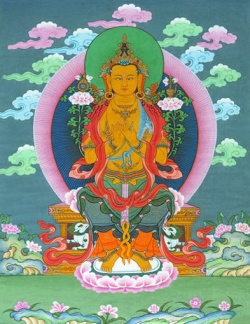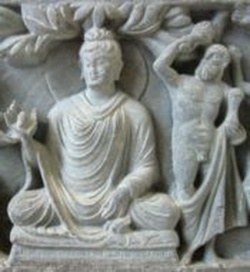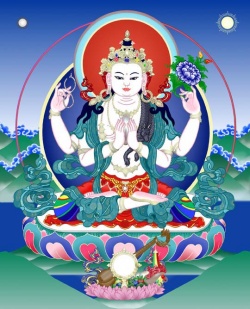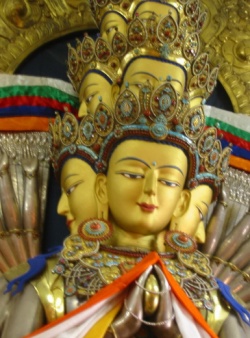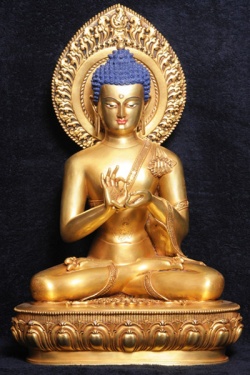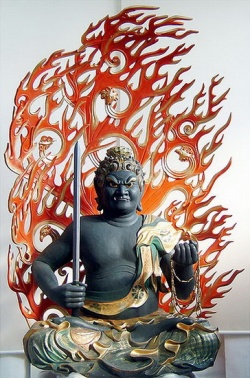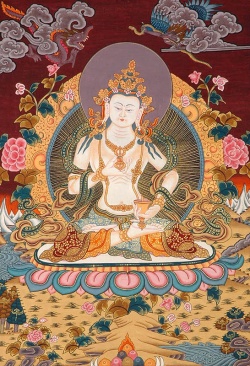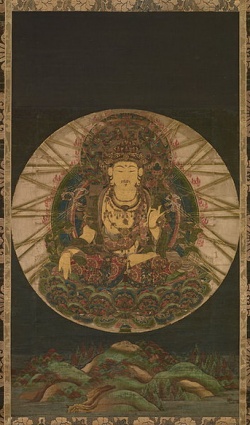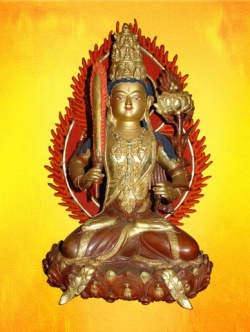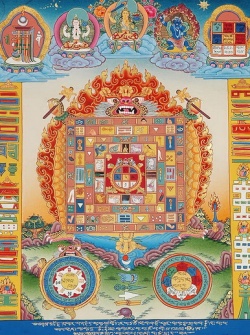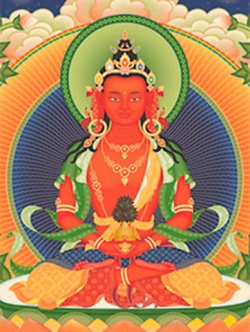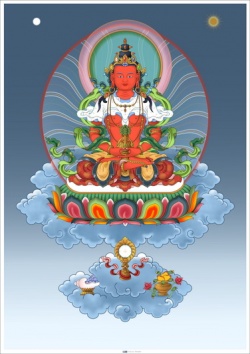A Defense of Yogaacaara Buddhism by Prof. Alex Wayman
Introduction: Defense from What?
There have been many discussions in India, where Yogaacaara originated, and elsewhere. Inevitably it was misrepresented and the misrepresentation repeated and copied. Now, this situation is much more complicated than would first appear. In India there was a practice starting from the Veda of memorizing texts by repetition and transmitting them orally. Much later in the A.D. period there was a writing down of such scriptures, and then a copying of them. The Buddhists transmitted their scriptures in a comparable manner, and the written-down canon was also copied. Such scriptures whether Hindu or Buddhist are regarded by the respective groups as conveying truth. Therefore, we cannot argue against copying itself. Clearly, it is what is copied that concerns us now, namely, whether or not there are misrepresentations. Then, as concerns 'misrepresentations', it could be asked: What is wrong with them? Well, some are good-natured and some are rather venomous. In general there is a great range of such, extending from speculations and guesses to downright lies, that are repeated and copied. In the case of misrepresentations of the Yogaacaara, I accept them as usually of the good-natured kind, whether it be a type of refutation in a Hindu commentary, or by a Buddhist opponent of the Yogaacaara. An important illustration of the Hindu type of refutation comes from the commentaries on the Brahmasuutras, where the author, say `Sa^nkara, can write in terms of the system itself, setting forth its tenets, or attempts to express certain tenets, while distorting an opposing system.(1) These Hindu systems and their rival systems were established by geniuses or otherwise brilliant persons. It might have been thought better that these rival systems not be presented correctly, or followers might get confused, wondering if their own system was indeed better, or whether a certain tenet being refuted was not really identical with a tenet of their own system. Therefore, when the Buddhist system supposedly being refuted in such a Hindu commentary can reasonably be identified with a sort of Yogaacaara position, it seems fair to conclude that it is a good-natured type of refutation one necessary for a successful commentary.
Perhaps the same judgment could be rendered for the quarreling between the Hindu logic 0school and the Buddhist logicians, which at least in modern times is acknowledged to have sharpened the arguments on both sides, so that when Buddhism left India around A.D. 1200, the Hindu logic school began to stagnate for lack of intelligent opposition. I interpret also the Maadhyamika Buddhist refutation of the Yogaacaara philosophical position to be a good-natured type probably more an exercise in discourse, with the premise that some tenets can be expounded in themselves and certain others can be clarified by the refutation of an opposing position. The Maadhyamika-type refutation of the Yogaacaara regarded its 'mind-only' (cittamaatra) teaching as a denial of the external world, and further took its 'store-consciousness' (aalayavij~naana) as an unwarranted addition to the traditional list of vij~naanas. Granting, then, that these sorts of refutations are not made out of malice, one must face the problem of what there is to defend against on behalf of the Yogaacaara. I claim that this system itself is its best defense. After all, Asa^nga, the founder, wrote the huge Yogaacaara bhuumi and the Mahaayaanasa.mgraha, while Vasubandhu, besides his commentary on the latter, as well as on the Da'sabhuumika-suutra and on the Madhyaantavibhaaga, popularized the system in abbreviated treatises. There is no lack of texts explaining this system, whether in an argumentative or in a no argumentative fashion. Therefore, the role of the present writer to defend the system really amounts to exposing it, taking it as the important thing, with ancient and modern writers less important in comparison. Accordingly, the defense of the system against anyone is really the system's own response; and the role of the present writer is to find this response of the system itself.
To illustrate what is meant by this kind of attitude, let us take the case of a review article I wrote for Philosophy East and West on Ashok Kumar Chatterjee's book expounding the Yogaacaara. I concluded: If Chatterjee's "Yogaacaara" is indeed the Yogaacaara person that Vasubandhu was, then Chatterjee's book is certainly a wonderful Exposition of the Yogaacaara philosophy. But, if the Yogaacaara fundamentals are what I have indicated above, happening to be in rough agreement with [P.T.] Raju and with Surendranath Dasgupta, the Chatterjee's book is still worth reading as a philosophical exegesis of what was traditionally held, principally by non-Yogaacaarins, to be the Yogaacaara position.(2)
When I wrote this, it was already known to me though not mentioned in there view that Chatterjee had adopted the very interpretation that his teacher T.R.V. Murti had espoused in chapter 13 of his well-known book on Maadhyamika.(3) As has already been acknowledged, there is nothing wrong with this kind of copying of a teacher's position. But it also shows that if what was copied was in fact incorrect, the copy is also incorrect. Still, we do not know yet if Murti was incorrect in that chapter. The present essay will deal with this matter later on.
Another example is the more recent work by Schmithausen on the Yogaacaara's aalayavij~naana teaching, wherein Schmithausen disagreed with a Japanese scholar, H. Hakamaya, who insisted that Asa^nga was the compiler of the entire encyclopedic Yogaacaara bhuumi. Here Schmithausen thought to counter Hakamaya's position by noting the use of thescripture Sa.mdhinirmocana in some parts or the larger work and not in other parts. About that scripture, Schmithausen concluded: "Therefore, the Sa.mdhinirmocana-suutra, at least the portions concerned with the new kind of vij~naana distinguished from the ordinary six, was most probably composed before the Vini'scayasa.mgraha.nii but after the Basic Section of the Yogaacaara bhuumi."(4) It happens that a Japanese student, H. S. Sakuma, completed a dissertation at Hamburg, approved by Schmithausen, wherein he presented (in German) this very position stated above hence copied. In my review of this published work I pointed out: "One may refer in my Analysis of the 'Sraavakabhuumi Manuscript, (5) 110-11, to a passage on the three doors of vipa'syanaa. This passage is virtually the same as is found in the Sa.mdhinirmocanasuutra, ch. 8, sect. 10. This is a proof that the author of the Sraavakabhuumi agreed to be the oldest part of what Sakuma calls Maulii Bhuumi [the 'Basic Section] had available and used the Sa.mdhinirmocanasuutra."(6)This, then, is an example of where the copying turned out to be incorrect, and was defended against by calling attention to what the Yogaacaara itself says about the matter.
These two examples should clarify what is meant by misrepresentations (or possible ones) that are defended against not really by the present writer s an independent thinker, but rather by the Yogaacaara system itself being brought to bear upon the alleged misrepresentation. This essay continues with two main sections below:
(1) The Position of the Yogaacaarins and (2) Clarification of the Position.
The Position of the Yogaacaarins
Here I present four topics:
Vasubandhu and an early scripture;
about cittamaatra;
about aalayavij~naana; and
about three lak.sa.na.
Vasubandhu and an Early Scripture. Some authors treat the Yogaacaara system as though it were an invention of the founders, notably the brothers Asa^nga and Vasubandhu. To suggest otherwise, may we notice that Bhikkhu ~Naa.nananda has put out a boolet on the Kaa.lakaaraama Sutta.(7) This scripture is in the A^nguttara-Nikaaya, Book of Fours, where it was translated by Woodward,(8) who noticed certain textual difficulties. The Bhikkhu used some other editions and studied Buddhaghosa's commentary on every word for his English rendition, wherein he obviously uses Woodward's words whenever possible. In the following I have substituted my rendition 'gods and humans' and subdivide the translation with brief, bracketed remarks.
The Kaa.lakaaraama Sutta. [The Setting.] At one time the Exalted One was staying in Saaketa in Kaa.laka's monastery. There the Exalted One addressed the monks, saying: "Monks." "Revered Sir," replied those monks in assent. [As a Vedic or Greek god would talk, declaring omniscience,] the Exalted One said: "Monks, whatsoever in the world with its gods, Maaras and Brahmas, among the progeny consisting of recluses and brahmins, gods and humans whatsoever is seen, heard, sensed (sensations arising from taste, touch and smell), cognized, attained, sought after and pondered over by the mind all that do I know. Monks, whatsoever in the world... of gods and humans, whatsoever is seen,... by the mind, that have I fully understood; all that is known to the Tathaagata, but the Tathaagata has not taken his stand upon it. [Now he denies alternatives to be construed as four in number, because the scripture is in the Book of Fours.] If I were to say: 'Monks, whatsoever in the world... of... gods and humans whatsoever is seen... by the mind all that I do not know' it would be a falsehood in me. If I were to say: 'I both know it and know it not' that too would be a falsehood in me. If I were to say: 'I neither know it nor am ignorant of it’it would be a fault in me. [The Buddha now declares how one uses the senses while avoiding the 'apprehender' and the 'apprehended'.] Thus, monks, a Tathaagata does not conceive of a visible thing as apart from sight; he does not conceive of an 'unseen', he does not conceive of a 'thing-worth-seeing', he does not conceive about a seer. He does not conceive of an audible thing as apart from hearing; he does not conceive of 'an unheard', he does not conceive of a 'thing-worth-hearing', he does not conceive about a hearer. He does not conceive of a thing to be sensed as apart from sensation; he does not conceive of a 'thing-worth-sensing', he does not conceive about one who senses. He does not conceive of a cognizable thing as apart from cognition; he does not conceive of a 'thing-worth-cognizing', he does not conceive about one who cognizes. Thus, monks, the Tathaagata, being such-like in regard to all phenomena seen, heard, sensed, and cognized, is 'Such'. Moreover, than he who is 'Such', there is none other greater or more excellent, I declare." [Now verses on how ordinary persons use their senses, sometimes called 'the fantasy of normalcy'.]
Whatever is seen, heard, sensed or clung to, is esteemed as truth by other folk. Midst those who are entrenched in their own views, being 'Such' I hold none as true or false. This barb I beheld, well in advance [i.e., at
The foot of the Bodhi tree), whereon humans are hooked, impaled. "I know, I see,'tis verily so"no such clinging for the Tathaagatas.
This scripture clarifies the Buddhist prescription "to see things as they really are," since it implies that one should simply see without adding anything. Recall the ancient Hermes epigram found on a Grecian urn: "Who shall say more, will lie."(9) As to the 'barb' of the verse, the Paali is salla.m, equivalent to the Vedic word 'salya, whichdown the centuries means an 'arrow', on which one is impaled (if such be the case). I have cited this scripture in this essay because I do believe that Vasubandhu's popularizing treatises have such a scriptural source in the background.
About Cittamaatra. Past writings on this topic uniformly render the term cittamaatra as 'mind only', and so do I also in my own former essays. Notice that such renditions take the topic outside India by way of Asian translations and essays in English and European languages. Inside India, where the term originated, the words citta and maatra appeared as such with connotations of Sanskrit words; outside, there was the connotation of the words 'mind' and 'only'.I propose to consider these words with their connotation in the Sanskrit language.
In current lexical work I have learned various usages of the term maatra.(10) The lexicons of India recognize a neuter form maatra.m and a feminine form maatraa, so the adjectives can go with the neuter or the feminine Of the two definitions for the neuter form 'all, the entirety' (kaartsnya), and 'restriction to the instance' (avadhaara.na) the adjective 'only' could agree with 'restriction to the instance'. The rendition 'only works for the other definition’ the entirety. For example, there is the compound sthaanamaatra, in the meaning 'a place in general', thus any and all places and excluding what is not a place. When cittamaatra is understood in this way, the citta is unmixed with anything that is not citta. Accordingly, if we suppose in the compound cittamaatra that maatra means 'only', then is only one of the two senses intended, or can it be both?
It is well to point out that other adjectives are feasible from the feminine maatraa. The definition 'any measure' (maana) yields the entry in Apte's Sanskrit-English dictionary paromaatra ('vast') for the spatial measure and, in the lexicons, tatkaalamaatra ('at once') for the temporal measure and also alpa ('a trifle') as wellas ak.sibhaaga ('a mirror'). As adjectives applied to cittamaatra, we could say 'amounting to mind' both spatially and temporally. Or we could say 'just mind' and 'mirroring mind', and, for the latter, perhaps also 'being mirrored by mind'.
In a previously published essay, I presented Asa^nga's statement on cittamaatra, which I translated in part.(11) It is clear that the Buddhist opponents did not criticize on the grounds that Asa^nga denied the existence of the external world (which, of course, he did not do). As the first attack, the opponent states: "it is not valid that there is a mind-only in the sense of a 'continuous substantiality' (dravyatas), because it contradicts scripture." The opponent is asked: "How does it contradict scripture?" That person responds: "He (the Buddha) said, 'If the citta consisted of lust defilement (upakle'sa) and consisted of hatred and delusion defilement, it could not become liberated.'" Asa^nga replies: "But what is the objection to that?" He seems to mean that we accept what the Buddha taught, and so if the citta does not consist of these defilements (or contain them), it would be liberated; hence your scriptural appeal cannot deny to mind-only a 'continuous substantiality'. The opponent does not give up, and retorts: "Mind-only by itself is invalid, because if there is not two together, when one does not resort to representation (vij~napti) of lust, etc., one would be free (of those defilements) [which we know is not the case]."
The opponent is obviously a follower of the Buddhist Abhidharma, which teaches that there is no citta without a caitta (caitasika- dharma) a mental'.(12) That we cannot have a citta by itself is the second meaning I treated above, the 'totality' sense, all citta, unmixed with anything else. But Asa^nga appears to espouse this 'totality' sense. His response starts by saying "There is no fault in a prior representation," and continues:
There is what was said by the Bhagavat, to wit, "concomitant (sahaja) feeling (vedanaa), idea (sa.mjnaa), and thinking volition (cetanaa),"and what was said (by Him), to wit, "These natures (dharma) are mingled, not unmingled, sothese natures are not objects individually separated out; or when separated out (not objects) for reference as distinct, or clear, or different." To demonstrate the meaning of the mingling he used the simile of the light of a butter lamp.(13) Accordingly, if they were not concomitant, it would also have been improper to say they are mingled.
Asa^nga has cited a scripture in Buddhist Sanskrit equivalent to the Mahaavedalla- the individual factors, because they are mingled.
Presumably, it takes a yogin to separate the mental items. Then this yogin can arrive at a pure citta. The Pata~njali Yogasuutra seems to have a similar idea when it refers to 'cessation of the modifications of the citta' (cittavr.rtti-nirodha).
Now I shall deal with three subtopics: (1) the phrase cittamaatra.m yad uta traidhaatukam, (2) the Yogaacaara theory of ekaagracitta, and (3) the theory that Vasubandhu denies the external world.
The Phrase Cittamaatra.m yad uta traidhaatukam. There is a rather famous passage in the Buddhist Da'sabhuumika-suutra, its Sixth Stage (bhuumi). This has been cited as cittamaatra.m yad uta traidhaatukam, and the scripture's translation by Megumu Honda, as revised by Professor Johannes Rahder, understands this to mean"This triple world is mind-only."(14) Sylvain Levi, in a learned note at the beginning of his French translation of Vasubandhu's Vi.m'satikaa (the Twenty Verses), presents several versions of this formula, in each case showing the form traidhaatukam, and he appears to recognize that the Da'sabhuumika-suutra is the source of such nonscriptural citations of the entire formula.(15) This passage has seemed to support the claim that the Yogaacaara denies the existence of the external world, as here, 'three worlds'--of desire, form, and the formless worlds, according to the usual Buddhist dogmatics.
Now, one of the difficulties of the usual translation and consequent interpretation is that this scripture, the Da'sabhuumika-suutra, is not really a Yogaacaara scripture. Indeed it is a basic scripture of ahaayaana Buddhism and is not devoted to the particular philosophical view of the Yogaacaara. The particular phrase was inserted by that scripture within a discussion of Dependent Origination, which is important to all Buddhist schools. Vasubandhu, in his great commentary on the Da'sabhuumika-suutra, gives two explanations for this phrase, neither of which promotes any particular theories of theYogaacaara school, even though the first explanation uses the Yogaacaara theory of multiple vij~naanas.(16) This first explanation goes into the Buddhist theory of waywardness (viparyaasa), and then announces that the 'mind-only' passage was promulgated so that one may be liberated from the 'store consciousness' (aalayavij~naana) and from other perceptions (vij~naana). Here, the sense of maatra.m seems to be 'amounting to', that is,'amounting to mind', where the 'mind' (citta) here stands for all the vij~naanas, counted as seven or eight. These are the perceptions (vij~naana) based on the five outer-directed senses, the manovij~naana based on the mind (manas) as an inner sense organ, and the 'store consciousness' (for 7), or number 7, the 'defiled mind' (kli.s.tamanas), plus the 'store consciousness' for 8. If someone of Madhyamaka persuasion had been commenting, probably only the first six vij~naana would be mentioned. Therefore, it is not a Particular Yogaacaara teaching here that is meant, but simply that these various perceptions are what lead to waywardness (viparyaasa) and then to rebirth according to the precepts of Dependent Origination. Vasubandhu was entitled to interpret the term cittamaatra by the set of vij~naana because the Abhidharma gives the terminological set citta, manas, vij~naana, which allows their mutual substitution in certain contexts;(17) and Candrakiirti's autocommentary on his Madhyamakaavataara also changes the cittamaatra of the famous formula about the'three worlds' to vij~naanamaatra in his section attempting to refute the 'store consciousness' (aalayavij~naana).(18)
The second explanation has to do with the formula of Dependent Origination, and here the'thought' is that of the Buddha, who realized the formula with just one thought (ekacitta) and then taught it in a twelvefold way. Here, the meaning of maatra.m is the temporal sense 'at once' or in temporal sequence when the twelve members are taught one after another, thus taking time, eventually to have the theory that the twelve amount to three lives.
And this information from Vasubandhu shows that the rendition of traidhaatukam as 'three worlds' is incorrect.The Sanskrit term is a derivative noun from 'three worlds' (tridhaatu). The derivative nouns of Sanskrit have to be interpreted by each such term. For example, Gautama is the derivative of Gotama; this is a family-type of derivative such that Gautama is the descendent of Gotama. The derivative pauru.sa from puru.sa (a human person or man) applies more to the present case, because as a masculine noun pauru.sa can mean 'human action' (karman) and 'the weight that one man with both hands can raise upwards' (uurdhvavist.rta-do.hpaa.nin.rmaana).(19) We can also interpret traidhaatukam in two ways. Both ways take the derivative here to be the formula of twelvefold Dependent Origination , that is, that it is derived from, or faithful to, the three worlds, so realized in one moment's thought by the Buddha and then taught in twelve terms. This one-moment's thought is a variety of cittamaatra. The other interpretation of the twelvefold formula is that it is the way of rebirth through waywardness due to the set of Vij~naana, and this is a different interpretation of cittamaatra. But rebirth requires that is, is related tothethree worlds. Neither of Vasubandhu's explanations in this commentary justifies the interpretation that the passage, so misrendered to wit, "This triple world is mind-only" has anything to do with denying the existence of the external world.
The natural question, then, is how should that Sanskrit phrase be rendered? I would offer: the derivative of the three worlds is only mind. That is to say, whatever may be the 'three worlds' in a minimal sense whatever else is attributed to them, an elaboration of them, a product of them has been added by the mind. In one case it was added by the mind of the Buddha the twelvefold formula of Dependent Origination. In the other case it was added by the mind of other sentient beings. Hence, such an observation agrees with the scripturetranslated above, the Kaa.lakaaraama Sutta, which gave the message that to see things as they really are, one must not add anything. Apparently the six senses (when normal) see things as they really are, and it is the perceptions (vij~naana) based thereon that do the adding. But this is the interpretation of cittamaatra when it is tantamount to the set of vij~naana. This shows that it was proper for me to cite that scripture as a background of Vasubandhu's position.
Besides, the large chapter 3 of Vasubandhu's Abhidharmako'sa and his own commentary is devoted to the worlds, which, when in two sets, are the world of sentience (sattva-loka) and the support world (bhaajana-loka).(20) He was therefore very familiar with the respective attributions of these two kinds of worlds. He would undoubtedly know of the scripture in the Diigha-nikaaya, III, called Agga~n~na-sutta (though in the Buddhist Sanskrit AAgama version) a scripture on the Buddhist theory of genesis. One may read the account in the translation of the Paali-version that, after a long period, this world passes away. This is the Indian theory of cycles, with the passing away and emergence of the 'support world'. The scripture mentions that with the passing away the sentient beings had retreated to a 'higher' realm that of Form (ruupa-dhaatu) and while the world was plunged in watery darkness, they were 'made of mind, fed on
joy, and were self-luminous. The earth reappeared like a scum on the cooling water and became endowed with color, odor, and taste. The sentient beings tasted this and found it very sweet. As they ate more and more, they gradually lost their self-luminance, while the moon and sun became manifest. The beings had evidently fallen into the realm of desire.(21) In such an account we see the prior disappearance and reappearance of the support world, and that the sentient world follows suit. Accordingly, the way of translating that phrase about cittamaatra and the traidhaatuka that I have had to discard, namely that the three worlds are dependent upon citta, would have been in direct violation of the Genesis story. I don't believe that Vasubandhu would have taken a position in his brief popularizing works in direct opposition to the Buddhist scriptures.
The Yogaacaara Theory of Ekaagracitta. It was pointed out above that the Buddha was credited with realizing the entire formula of Dependent Origination with "one-moment's thought." In that place, the term was ekacitta. The theory of Buddhist meditation sets forth a goal called samaadhi, which is defined as ekaagracitta. This term has frequently been rendered "one-pointed thought (or mind)." Then what is meant by the Sanskrit word agra? Since this is an important term in the Sanskrit language, the Indian lexicographers have had to make it a defined word. Over four of their lexicons include for it the definition aalambana.(22) Literally, this means a 'support'. Many years ago I learned that this is the basic term in Buddhism for the 'reflected image' in the mind,(23) which is what one should meditate upon, given that it is an appropriate object for such meditative purposes. It follows that such a definition permits a translation for the entire compound ekaagracitta, namely "mind on a single meditative topic." Also, see Vasubandhu's Abhidharmako'sa, chapter 1, for a similar distinction between the outer sense object (vi.saya) and the mental reflection (aalambana).(24)
Besides, three of these four lexicons also defined the expression ekaagra, namely as "a single continuity" (ekataana) and as "being without discord" (anaakula). So the expression ekaagracitta can be further explained for the practice of a yogin, to wit, "the mind or consciousness as a single continuity and as without discord."(25) The two definitions go together, because the continuity would be broken if the mind were subjected to discord. And in such a case there would not be a "single meditative object." This is an implicationof the definition I found, namely ekataana, because this contrasts with a well-known Buddhist term, sa.mtaana, which is usually understood as a "stream of consciousness, " but which the foregoing information suggests should be better rendered as a"mingled stream of consciousness." I should call attention to the fact that the prefix sam- in Sanskrit is cognate with an Indo-European prefix that is present in English as con- in the sense of "together," that is, that in the ordinary case of a sa.mtaana, the continuity (taana) is composite. Therefore, when a modern Tibetan author, Lozang Tsewang, in a published seminar paper, writes, "Lord Buddha says in the suutras: 'The consciousness of a sentient being is of a single stream'"(26) (but does not identify the suutra so saying), the cited passage might mean what I called attention to above, that although the mental factors are mingled, a yoginif successful may separate out the citta and find it consisting of a single stream. But it is important to notice that the yogin does this with his own mind, and because he is engrossed in asamaadhi. He does not do this separating out in the minds of other sentient beings, who cannot verifythat the consciousness is of a single stream, forthe reasons that the mental factors are mingled and that they have not learned how to go into the appropriate samaadhi. This Tibetan author attempted to apply that cited passage in a philosophical treatment of the Yogaacaara position. But it is not valid to argue that something is the case with all minds (and their presumed objects) when it was only the case of a certain yogin and his personal attainment.
The Theory that Vasubandhu Denies the External World. Certainly some readers decided that Vasubandhu's twenty-verse treatise (the Vi.m'saatikaa) involves a denial of the external world. And such persons are entitled to say: suppose we grant your previous argument about cittamaatra and the traidhaatuka. Even so there are verses in
that Vasubandhu treatise that appear to deny the external world. Before going into those particular verses, it is well to notice the situation in his Abhidharmako'sa. Abhidharma Buddhism recognizes six senses and their objects, from the sense of eye with its object of formations (in shape or color) to the sense of mind (manas) with its object of natures (dharma). But this does not mean that one necessarily perceives such sense objects. So Buddhism taught that there is a 'perception' (vij~naana) based on the eye, and so with the other senses as bases (aayatana). Because the senses had the power to apprehend those various objects, they were given the Sanskrit name indriya, a word which means 'a power'. It follows immediately that 'perception' ispowerless; that is, it is unable to contact the object directly, but must depend on whatever the sense organ comes up with.
Bareau presents the manner in which Vasubandhu treated this matter in his Abhidharmako'sa:(27) ruupa.m pa~ncendriyaa.ny arthaa.h pa~ncaavij~naptir eva ca (1, 9) ("Formation is five sense organs, five objects, and non-representation"); cak.su.h pa'syati ruupaa.ni sabhaaga.m na tadaa'srita.m vij~naana.m d.r'syate ruupa.m na kilaantarita.m yata.h (I, 42) (Bareau's translation: "When it is in condition to work, the eye sees formations; the consciousness which is leaning on it does not (see formations), because formation, then being concealed, is not seen"). If we grant that perception fails to reach the object that was apprehended by a sense organ, we begin to notice how perception, perhaps automatically, adds to the sensory evidence, as was discussed above. And this may help to explain why the same art object is viewed differently by different persons presumably it was about the same as a sense object, but the subjective perceptions evaluate it quite divergently.
Now to the twenty-verse treatise. The translation from the Chinese by Hamilton(28) was reprinted in A Source Book by Radhakrishnan and Moore.(29) We learn there that these twenty verses are on vij~naptimaatrataa, there rendered 'Representation-Only'. It is somewhat embarrassing to me to point out what the editorshave added in their footnote on page 328, because I have always had great admiration for both Radhakrishnan and Moore. They say: "A better translation of vij~naptimaatrataa would be 'ideation-only, ' since 'representation' suggests rather than denies external reality." Well, no fair mistranslating a Sanskrit term just to make one's theory come out right! That remark was made because of thinking that Vasubandhu's treatise denies external reality.
Sylvain Levi's edition (30) of the Sanskrit for the twenty verses numbers them as twenty-two. His verse 1 can be taken as introductory, and his verse 22 as concluding. The translation from the Chinese, as presented by Hamilton, starts with Sanskrit number 2 as the first verse. This is Levi's introductory verse with my translation:
vij~naptimaatram evaitad asadarthaavabhaasanaat/
yathaa taimirikasyaasatke'sacandraadidar'sana.m//
This just amounts to representation, as the sight of unreal hair, moon, etc. of one with an eye caul because being the (subsequent) manifestation of an unreal artha (external thing).
This introductory statement does not deny an external object. Instead there is a mental representation that amounts to tinsel, 'fool's gold',
a false wealth. Vasubandhu appears to mean that the mind imagines an external artha in front, but the mind has only a report or representation of what the sense organ had sensed.
This is Levi's verse, and what for both the Chinese and the Tibetan is verse 1, with my rendition (Levi had to reconstruct the Sanskrit):
yadi vij~naptir anarthaa niyamo de'sakaalayoh/
sa.mtaanasyaaniyama's ca yuktaa k.rtyakriyaa na ca //
If representation lacks an external object (artha), there is no certainty (aniyama) of space and time; there is no certainty of the composite stream (of consciousness) and agency is not valid.
We notice again that Vasubandhu does not here deny an external object, because the sentence makes a supposition, "If...." The verses go on to make a distinction between the beings of different destinies, gods, humans, hungry ghosts, and so forth, in how they view externals. Thus the gods see the river sparkling with gems, humans see it as good to drink, and the hungry ghosts (preta) find the river full of unclean things rendering it unfit to drink. We notice this difference in terms of destiny classes that it involves the use of external things. Again, it is not a denial of external objects, but a claim that different destinies have a different addition (philosophically false) to what was sensed. Then there is what is numbered verse 16 in Hamilton's translation, where he renders the first part as follows: "As has been said, the apparent object is a presentation. It is from that memory arises" (the Sanskrit for this: ukta.m yathaa
tadaabhaasaavij~napti.h; smara.na.m tata.h). Hamilton translates the commentary on this:(31) "As we have said earlier, although there is no external object, a sense representation, visual, etc., appears as an outer object. From this comes the later state with its memory associate, the discriminated mental representation, appearing as a seeming former object. Then we speak of this as a memory of what has been already experienced." Notice that Hamilton translated the first sentence of this commentary as though there is denial of the copula ("although there is no external object"). But when we consult the Sanskrit that Levi edited, we find the sentence worded differently: "Even in the absence of an external object" (vinaapy arthena). It is necessary to translate this way to make sense of the comment that Hamilton translates from Chinese:(32) "That is, he defends his position by saying that there must have been this object immediately received in the past by the five organs of sense, eye, etc. [so that] in the present the intellective consciousness is able to hold it in memory."
We have probably all had such an experience, when concentrating on some problem or passage, if someone comes to the door and says, "Dinner is ready" and, not immediately hearing a response of the type "O.K. I'm coming, " continues, "I said: 'Dinner is ready'! "whereupon the concentrating person responds, "I heard you the first time" not exactly as this person now says it, because if we mean by hearing the actual sounds as heard at the time the sounds are made, this is true just for the reception by a sense organ (of hearing), and not true for auditory perception. According to Vasubandhu, as the Chinese commentary here understood him, the person remembered the words "Dinner is ready." Thus, "even in the absence of an external object, "that is, even though that sound is no longer sounding, a person may hear it as a memory image. Due to the actual experiences of yogins, this situation was taken for granted. There is a celebrated case associated with what in Buddhist history is called the Second Council, to determine if certain erring monks should be ousted from the Sa.mgha: all the senior monks were called to assemble for the hearings, but one of these monks was in the deep concentration called nirodha-samaapatti. According to the story, upon hisemerging from the samaadhi a divinity gave him the message, whereupon he sped to the meeting.(33) It should be admitted that this yogin remembered the message, while the instigating sound was no longer sounding.
Thus, when we examine the text more carefully, we find that Vasubandhu does not deny the existence of external objects in this and in the previously cited materials, even though the translator, just by his manner of translating, made it appear so. Besides, two authors of recent books translating a number of the Vasubandhu treatises agree that Vasubandhu does not deny an external object (Kochumuttom(34) and Anacker(35)).
As to Murti's chapter, previously alluded to, a few words will suffice. A reader of that chapter, supposedly on the 'absolutism' of Vedaanta,
Maadhyamika, and vij~naanavaada, will readily find out that the Yogaacaara position (called here 'Vij~naanavaada') is set forth, not from Yogaacaara books, but from their rival Vedaanta and Maadhyamika
books. Having decided that the opponents must be right, when he then cites a Yogaacaara treatise it must be made to agree with Murti's supposition. So, referring to the Madhyaantavibhaaga, he says, "The
constructed subject-object world is unreal; but this does not make the abhuutaparikalpa unreal; for, it is the substratum for the unreal subject-object duality. It is, however, non-conceptual."(36) So
abhuutaparikalpa, which means "the imagination of what did not (really) happen," is 'non-conceptual'! I conclude that Murti in this chapter does not advance the understanding of Yogaacaara Buddhism.
About Alayavij~naana. When we turn to the Yogaacaara theories that devolve about the term aalayavij~naana, we notice that what must have been a hotly contested point even in the time of the Buddhist master Asa^nga is still in present times disputed. I already mentioned that there is a two-volume work on the topic by Schmithausen. Here, under a heading "Introduction and Original Meaning of AAlayavij~naana," he points to a passage in the Samaahitabhuumi portion of the Yogaacaarabhuumi about a person in the deep concentration called nirodha-samaapatti, and that it is a continuance of the aalayavij~naana with its seeds, which shows that even though various other mental functions have ceased, vij~naana itself has not ceased, and these seeds will bring forth the evolving types of vij~naana when the person emerges from the samaadhi.(37) Schmithausen calls this the "Initial Passage" here and a number of times later on in his work. He goes on to claim (38) that the passage, although not stating this explicitly, implies that the continued presence of the aalayavij~naana has kept alive that yogin who is in nirodha-samaapatti. And if that is so, then the aalayavij~naana must also be associated with the moment of conception in the womb, (39) and so this is the vij~naana on which Name-and-Formation (naama-ruupa) arises in dependence in the usual sequence of the Buddhist Dependent Origination. Accordingly, he insists that the pratisa.mdhi (or 'linking', the 'rebirth') kind of vij~naana is that initial aalayavij~naana that descends into the male-female element union in the womb.(40)
In the course of his investigation he was led to disagree with various Japanese scholars who understood these matters differently from him. I shall have to evaluate whether his conclusions are consistent with the positions of Asa^nga, the founder of the Yogaacaara, or of Vasubandhu, the great popularizer thereof. It happens that Asa^nga himself obviously responding to a number of challenges and condemnations of this aalayavij~naana position gave his answers in the opening section of his exegetical section called Vini'scayasa.mgraha.nii, which I employ in the Tibetan version in the Tanjur. There we learn that the 'store consciousness' is the abode of seeds (aalayavij~naana.m biijaa'sraya.h) .(41)Asa^nga claims that this is a secret teaching of the Bhagavat, citing a well-known verse from the Sa.mdhinirmocana-suutra about the aadaanavij~naana (the consciousness that 'takes' (seeds)).(42) But the reader of this section cannot avoid the conclusion that Asa^nga is convinced that of the many references to vij~naana in the old Buddhist Sanskrit canon (the four AAgamas) that he employed, they cannot all be explained as the standard six perceptions based on the six sense organs, but that there are various contexts of this Sanskrit expression which justify it to be understood differently.
Now, as Asa^nga continues in his defense of this type of vij~naana, he sets forth three reasons that surprisingly were not referred to by Schmithausen. I shall cite the Tibetan along with my translation below each passage, and then follow with a discussion insofar as it is possible.
/ ci'i phyir kun gzhi rnam par 'ses pa med na lus kyi tshor ba mi rung zhe na / 'di ltar tshul bzhin nas tshul bzhin ma yin pa sems par byed pa dang / rjes su rtog par byed pa'am / sems mnyam par bzhag pa'am / sems mnyam par ma bzhag pagcig cig lus la tshor ba rnam pa du ma rnam pa
mang po sna tshogs gang dag 'byung ba'i rigs na snang ste / de'i phyir yang kun gzhi rnam par 'ses pa yod do /(43)
1. Why in the absence of aalayavij~naana is the body's feeling not feasible? It is this way: when positing that the mind attends in the right
manner and then imagines in the wrong manner; or that the mind is equipoised, then is not equipoised, there appear principles that bring
forth a multitude of aspects of varied kinds of feelings in a certain body. Therefore, there is the 'store-consciousness'.
/ ci'i phyir kun gzhi rnam par 'ses pa med na sems med pa'i snyoms par 'jug pa mi srid ce na / 'di ltar 'du 'ses med pa la snyoms par zhugs
pa'am/ 'gog pa la snyoms par zhugs pa'i rnam par'ses pa lus dang bral ba kho nar 'gyur zhing ma bral bar mi 'gyur bas / de'i phyir 'si ba kho nar 'gyur ba zhig na bcom ldan 'das kyi de skad du / de'i rnam par 'ses pa ni lus dang bral ba ma yin no zhes gsungs pa'i phyir ro /(44)
2. Why in the absence of aalayavij~naana would there be no possibility of equipoise without thought (acittika-samaapatti)? It is this way: the vij~naana that is in non-ideational equipoise (asa.mj~nika-samaapatti) or is in cessation equipoise (nirodha-samaapatti) only occurs when it is absent from the body, and would not occur [that way] when not absent (from the body). For that reason, it was only for the case of death that the Bhagavat declared, "his vij~naana is not absent from the body."
/ ci'i phyir kun gzhi rnam par 'ses pa med na 'chi 'pho mi rung zhe na / 'di ltar 'pho ba'i tshe'i rnam par 'ses pas lus ro stod dam / ro smad du drod yal bar byed cing spong la yid kyi rnam par 'ses pa ni nam yang mi 'byung ba ma yin bas / de'i phyir lus len par byed pa'i kun gzhi rnam par 'ses pa kho na dang bral bas lus kyi drod yal ba dang / lus la tshor ba med par snang bar zad kyi / yid kyi rnam par 'ses pa dang bral bas ni ma yin te / de'i phyir yang mi rung ngo/(45)
3. Why in the absence of aalayavij~naana is there no feasibility of transmigration? It is this way: the vij~naana at the time of [dyingand] transmigrating leaves when the warmth of the upper and lower parts of the body fades away, and the manovij~naana certainly does not occur and is not [at that time). On that account, only in the absence of the aalayavij~naana which takes a body does feeling (vedanaa) get lost in the body, but this does not happen through the absence of manovij~naana. So there is no feasibility (in the absence of aalayavij~naana).
One of the first conclusions about these three passages is that Schmithausen was wrong in concluding that aalayavij~naana was necessary so that a meditator who is in the trance state nirodha-samaapatti would not die there. Certainly, if Asa^nga had thought so, this would be the place for him to have said so. It is a case when vij~naana departs from the body, but the person does not die(on that account). But when a person does die, vij~naana does depart from the body. However, the three passages certainly require further explanations. A certain amount of explication should come through considering certain Schmithausen claims as were eluded to above.
As to his view that the aalayavij~naana is the kind of vij~naana that descends into the male-female element union in the womb, supposedly bringing life thereto, there is Asa^nga's own explanation in the early part of the Yogaacaarabhuumi:
(tatra) sarvabiijaka.m vipaakasa.mg.rhiitam aa'srayopaa adaanaad aalayavij~naana.msammuurcchati /(46)
There, the 'store-consciousness' all-seeded and restrained by maturation, after taking a body, faints (or falls unconscious, or becomes inactive).
And:
yatra ca kalalade'se tad vij~naana.m sammuurcchita.m so 'sya bhavati tasmin samayeh.rdayade'sa.h /(47)
Where that vij~naana faints in a place of the kalala (initial form of the embryo), it [that place] becomes for it [the embryo) at that time the place of the heart. Notice that in this account, the initial form of the embryo after conception is already there when the 'store consciousness' enters. The term kalala is used in Indian medicine for the initial embryo. So it is a case like the Genesis account already mentioned where the support world precedes the subjective element. Thus while Schmithausen was right about the role of aalayavij~naana to represent in some way the vij~naana that is the third member of Dependent Origination, and so to fall into the womb (in the human case), it is clear that Asa^nga does not, and would not, ascribe to vij~naana the role of conferring life as Schmithausen claimed. These remarks help to explain somewhat the third of Asa^nga's defenses of the aalayavij~naana.
Then Schmithausen claimed, and repeated his claim, that this aalayavij~naana that falls into the womb is the pratisa.mdhi (rebirth) type of vij~naana. Apparently because some pandits were espousing such a theory at the time of Vasubandhu, he countered it in no uncertain terms in his Dependent Origination commentary: "it is not right that the pratisa.mdhivij~naana is by way of sa.mskaara [the second member of Dependent Origination). It is true that vij~naana arises [as the third member]; the Name-and-formation (naama-ruupa) [as the fourth member] arising on that basis is the time of pratisa.mdhi this is the faultless position."(48) Gu.namati claims that Vasubandhu's Abhidharmako'sa identifies the pratisa.mdhi ('linkage' reincarnation) with the skandha kind of vij~naana.(49) He presumably means chapter 3, the introductory paragraph to k. 14, where the first line in the Sanskrit text has the expression "five upaadaana-skandha," and in the next line it says "The moment of pratisa.mdhi is the birth in the destinies (gati) " (upapattibhavo gati.su pratisa.mdhik.sa.na.h).(50)
Buddhaghosa helps to make sense of the foregoing when, in his famous work Visuddhimagga, he sets forth under the topic of the fourth member of Dependent Origination that the naaman (of naama-ruupa), when initially developing in the womb, consists of three aggregates. That is, he defines it, vedanaadayo tayo khandhaa, "the three personal aggregates, feelings, etc.,"(51) thus leaving out vi~n~naana (the Paali way of writing vij~naana), while the standard Abhidharma listing of the naaman part presents the four members, including vij~naana. This forces the well-known canonical passage holding that naama-ruupa arises in dependence on vij~naana and that vij~naana arises in dependence on naama-ruupa to mean that vij~naana is added to the foundation of reifying views
(satkaayad.r.s.tyadhi.s.thaana), and foundation of 'I am' pride (asmimaanaadhi.s.thaana) and any others belonging to the same set.(52) Besides, Asa^nga gives a list of various outcomes of these seeds: family (kula), strength (bala), bodily appearance(ruupa), length of life (aayus), enjoyments (bhoga), and so on; and of these effects, principally good ('subha) and bad (a'subha) karma is the cause.(53)
Later, Asa^nga told how this 'store consciousness' gets its seeds:
evam avyaak.rtaa dharmaa ku'salaaku'salaavyaak.rtaan dharmaan aavahanti / tadyathaa ku'salaaku'salaavyaak.rtabiijakam
aalayavij~naanam aavahanti /(54)
Thus,the indeterminate natures (avyaak.rtadharma) bring the virtuous, unvirtuous, and indeterminate natures, as follows: they bring (them) to the 'store consciousness', which is seeded with the virtuous, unvirtuous, and indeterminate.
Previously it was mentioned that the Yogaacaara frequently presents a list of eight vij~naana, of which number 7 is the 'defiled manas' and number 8 is the aalayavij~naana. Now, in Buddhist commentarial exegesis of the scriptures, there was a problem with the vij~naana that is third in Dependent Origination, and was said to have a'vision' of the birthplace and so to be attracted thereto. Now, even in the Yogaacaara, it would hardly be feasible to identify this third member with the aalayavij~naana, since a store of seeds could hardly be called visionary, except for the envisioning of effects, as an acorn might be said (poetically or metaphorically) to foresee the oak tree. But however we might credit the acorn with such an ability, we should all admit that the acorn cannot imagine where it will grow. Vasubandhu was well aware of the difficulty, so in his Mahaayaasa.mgraha commentary he said: Besides, when the manovij~naana that is defiled witnesses the birthplace, the intermediate state [between death and rebirth) comes to an end. That it "faints" means that the manovij~naana comes together with the male and female generative elements, [and] experiences a single (moment of] bliss, whereupon the manovij~naana faints [i.e., becomes unconscious or inactive], and on the basis thereof, a different sort of manovij~naana enters."(55)
Since Asa^nga had already denied that the manovij~naana (i.e., the one based on the manas as the sixth sense) is operative at the time of death, Vasubandhu must mean the seventh vij~naana, what in later Yogaacaara was referred to as the 'defiled mind' (kli.s.ta-manas). Later, Vasubandhu comments: "Therefore, the manovij~naana that faints is not [i.e., is no longer] a manovij~naana, but is a vipaaka-vij~naana [i.e., a resultative kind]; and that is 'all-seeded'."(56) He therefore admits that it was the 'defiled mind' that falls into the womb and, once there, is called aalayavij~naana. This separate category of a 'defiled mind' seems to have been adopted for the death vision, for the visions during the intermediate state (antaraabhava), for the birth vision, and perhaps also (just my own speculation) for hypnogogic states during a lifetime.
Now, as this 'store consciousness' is credited with having a store of 'all' dharmas, we should recall that in Buddhist Abhidharma it is the manovij~naana that has those dharmas supposedlyas object, while it is the sixth sense manas that has those dharmas directly as object. In the theory of Dependent Origination alluded to above, for a vij~naana that arises in dependence on Name-and-Formation, Gu.namati explains that the manovij~naana is the main one: "Given the set of six vij~naana, only manovij~naana is the fastening (Tib. sbrel ba) of pratisa.mdhi (the reincarnation)."(57)
This means that the fourth member Name-and-Formation is necessary for the Abhidharma manovij~naana to operate; so the remaining vij~naanas, based on the five outer-directed senses, must require the fifth member, the Six Sensory Bases (.sa.daayatana), to operate.
All the foregoing should clarify that the chief demand to have the concept of aalayavij~naana was for Asa^nga's third reason the theory of rebirth.
Schmithausen's theory that the initial place is the context of a special yoga state that is, nirodha-samaapatti is hardly tenable. The discussion at some length in the early part of the Yogaacaarabhuumi shows that it was the Buddhist arguments over whether some persons had or did not have the potentiality of Nirvaa.na,(58) and the attempt to justify events of the present day as the effect of previous lives, that demanded a carrier of a seed-nature. This must be why Asa^nga allows for the operation of aalayavij~naana when the 'evolving perceptions' are in abeyance.(59)
But then there are the first and second reasons that Asa^nga mentioned. These are quite difficult because yoga states are implicated. When Asa^nga mentioned, as cited above, that vij~naana entered the embryo at the place where the heart would form, this makes it clear that when he said in the second reason that in the case of those two kinds of samaapatti the vij~naana is absent from the body, it means that vij~naana had left its 'heart' location, and was somewhere else for the time being (in the head?). This suggests that the yogin is in a sort of cataleptic state. And this seems to be why, in the first reason, Asa^nga had credited the 'store consciousness' with enabling the feelings of the body. Thus, in certain trance states there is a local or more general loss of feeling, and Asa^nga claims that to understand what is going on in these specialized states, one must posit a 'store consciousness'. This appears to be enough for these three reasons, as far as this essay is concerned.
It would also take too much space to go into the matter of the transmutation of the 'store consciousness' (aalayavij~naana-pariv.rtti), and the matter of which advanced persons a Buddha, an arhat, advanced bodhisattvas, and so on have transmuted this 'store consciousness' and so do not possess it.(60) But this teaching shows that the aalayavij~naana theory does not require it for the yoga experience of ekaagracitta, as it was discussed above, which implies a special condition of the evolving perceptions, especially manovij~naana (the perception based on the mental sense of mind, manas).
About Three Lak.sa.nas. There is considerable treatment already in Western sources on the three lak.sa.nas of Yogaacaara theory that are also called the three svabhaava. Nagao has written a spirited essay on the topic, "The Buddhist World View as Elucidated in the Three-Nature Theory and its Similes."(61) As Nagao describes the three, they are the imagined nature (parikalpita-svabhaava), the other dependent nature (paratantra-svabhaava), and the consummated nature (parini.spanna-svabhaava). And he explains: "The 'imagined' nature, therefore, is characterized by 'unreality' and 'total nonexistence'." "In contrast to this, parini.spanna or 'consummated' means perfect, real, and existent and connotes 'reality,’ 'truth,' 'real existence', or 'the absolute'." "Between them is the third nature, called paratantra, the 'other dependent'. It exists, but only by depending on some other entity."(62)
Nagao cites an important observation from Vasubandhu's Tri.m'sikaa, k. 21c-d: "When the other-dependen nature obtains a state absolutely free of the imagined nature, it is then the consummated nature."(63)
It is the conclusion of the present writer that this system of three natures is very close to what is found in the writings of the earlier and famous
Naagaarjuna, with the difference that the Yogaacaara thought it was improving in describing what is going on. I allude to two verses in the latter's Acintyastava, 44-45:(64)
hetupratyayasambhuutaa paratantraa ca sa.mv.rti.h / paratantra iti prokta.h paramaarthas tv ak.rtrima.h //44 svabhaava.h prak.rtis tattva.m dravya.m vastu sad ity api / naasti vai kalpito bhaavo
paratantras tu vidyate //45
Convention, with dependence on other(s) (paratantra), arises from a cause an from conditions. This dependence on other(s) has been announced (byThee). The Absolute is not fabricated. (44) It (the Absolute) is termed self-existence (svabhaava), primary nature (prak.rti), reality (tattva), substance (dravya), abiding essence (vastu), the really existent (sat). An entity (bhaava) when imagined does not exist, but (exists) when its dependence on other(s) is found. (45)
Notice the complete agreement with the Yogaacaara that an entity when imagined does not exist, but does exist with its dependence on another; and the same word for dependence on another (paratantra) is used. Naagaarjuna, like the Yogaacaarin espousers of the three svabhaava theory, has an absolute, defined by six terms. The only seeming difference is when Vasubandhu holds that this absolut nature is the other dependent nature when the latter is free of the imagined nature. This amounts to accepting for Dependent Origination (pratiityasamutpaada) that there is both a conventional and an absolute explanation. Even if Naagaarjuna accepts this, it would probably be difficult to draw it from his works. This brief account of the three natures should suffice.
Clarification of the Position
Here I present three clarifications: (a) in terms of subject and object, (b) in terms of Buddhist logic, and (c) in terms of Western discourse. Clarification in Terms of Subject and Object.
Previously I discussed the position in Vasubandhu's treatise of twenty verses and rejected the claim that he denied external existence. But more needs to be said about this. Vasubandhu in this brief work of his used the term artha for the presumed external object. Thereby he could only implicate the five outer-directed sense bases that have these arthas as
objects. The word artha in its general Indian usage stands for property and goods, and of course these stay behind when a person passes to the other world.
This usage of the term seems to be involved in its etymology.(65) The sixth sense, manas, has the set of dharmas as object; and by the indian theory of transmigration, some of these may well be held to transmigrate.
Let us now consider the treatment in Matilal's book Perception. In an "Analysis of Perceptual Illusion" he has a subsection on two Buddhist
analyses of illusion, admitting that he follows Vaacaspati Mi'sra for these materials; and this is quite proper, because he aims just not to
misrepresent the Hindu author. Matilal summarizes the Yogaacaara position in seemingly well-stated sentences, which I shall number: (1) "The object-form is an integral part of the awareness itself, each awareness being different from another by virtue of this unique object-form which appears in it." (2) "The object form does not come from outside."(3) "in fact when the object-form is projected outside or externalized, we are said to have an awareness of the external object."(66) In all three statements, Matilal attributes to theYogaacaara that there is an 'object-form' in the mind. But when we refer to what Vasubandhu said (in his Vi.m'saatikaa), we find him explaining the 'representation-only' not as an artha, the external object, but as an 'unreal object form' (asadartha)-a poor copy of the external object. Such a term affirms, rather than denies, what is connoted by the term artha, when it is employed by itself. Vasubandhu apparently used the term artha instead of the standard Buddhist vi.saya to fend off misattributions of the position he followed. Still, he was misunderstood, and these misunderstandings were copied over and over.
Then there is the essay in Philosophy East and West by Prasad, who, like Matilal, is a good writer on these topics.(67) He cites Vasubandhu's treatise on the three natures, the Trisvabhaavanirde'sa, as follows:
What is the conception of that which is nonexistent? [The answer is] 'mind' (mental projection] / For by it, the nonexistents are imagined; and inasmuch as the mind imagines objects, they do not exist at all.
What is that which is presented in cognition? The non-existent which is projected [or imagined). How is that presented in cognition? In the form of a twofold appearance [of the apprehender and the apprehended] / What is it in cognition that does not exist? That by which the twofold appearance is affected. Using the Sanskrit for the verses as is found in Kochumuttom,(68) I accept Prasad's translation as on the whole correct. In the case of the second of his cited verses, his rendition may possibly mislead the reader, as suggesting that a nonexistent external has appeared in the mind. I believe that here we should adhere more literally to the Sanskrit: tatra ki.m khyaati asatkalpa.h katham khyaati dvayaatmanaa ("What appears there? The imagination of an unreal. How does it appear? As the subject-object duality"). This subject-object duality is found discussed in Buddhist literature generally by the terms graahaka (the apprehender) and graahya (the apprehended). The avoidance of the two is the topic of the scripture presented above, the Kaa.lakaaraama Sutta. Thus, when Vasubandhu writes such verses, he evidently believes that they are consistent with the Buddha's teachings.
Clarification in Terms of Buddhist Logic. Stcherbatsky and others claimed that there is a pronounced influence of Yogaacaara philosophy on Buddhist logic of the Dignaaga-Dharmakiirti lineage.(69) If one is to credit the Yogaacaara with such influence, one should state the influence rather specifically. I have previously published three essays on this matter, "Yogaacaara and the Buddhist Logicians, "(70) "A Reconsideration of Dharmakiirti's 'Deviation' from Dignaaga on Pratyak.saabhaasa,"(71) and "Dharmakiirti and theYogaacaara Theory of Biija."(72) In the first of these essays I translated Dignaaga's brief treatise, the Alambanapariik.saa, which deals with the theory of 'atoms', which Vasubandhu also dealt with in his twenty-verse treatise. I also cited the commentator Dharmottara's passage explaining the so-called atoms as constituting color (var.na), while the shape (sa.msthaana) was added, presumably in Representation-Only. The article "A Reconsideration..." defended Dharmakiirti's position that there are four kinds of falsification of perception (pratyak.saabhaasa) and that this was also Dignaaga's position. The one on Dharmakiirti and biija showed that Dharmakiirti was amenable to this 'seed' way of talking.
Among the many authors who claim this Yogaacaara influence is C. L. Tripathi, who wrote a book titled The Problems of Knowledge in Yogaacaara Buddhism that included a treatment of Buddhist logic. He is
among the many who think that Yogaacaara Buddhism denies external existence, saying: "Vasubandhu...categorically denies the existence of the external world."(73) Yet this same author has a chapter "Object of Perception" presenting the position of Buddhist logic that the object called svalak.sa.na is the only real.(74) He calls it a 'particular', using the Western terminology of 'universal' and 'particular'. This author seems not to realize that if the Yogaacaara does indeed deny external objects, it opposes Buddhist logic and so why treat Buddhist logic in a book with such a title? Now I shall continue the discussion with the 'falsification of perception', because this apparently agrees with the Yogaacaara 'representation only'. Vasubandhu's commentary on the Mahaayaasa.mgraha, its chapter 2, speaks of 'representations' (vij~napti) belonging to the body, the body-possessor, and the eater. Here 'body' means the five realms (dhaatu) of (sense organs), eye, and so forth. 'Body-possessor' is the 'defiled mind'.
The 'eater' (or enjoyer) is the realm of mind (manodhaatu), that is, mind (manas), the sixth sense.(75) Another relevant passage is in
Vasubandhu's Karmasiddhiprakara.na (I translate from the Tibetan): "There are two kinds of citta:
what collects its seeds (aalayavij~naana);
(2-a) what has it (i.e., the aalayavij~naana) as a mental support (aalambana), namely the 'defiled mind' (kli.s.tamanas);
(2-b) what has images (aakaara) of it (i.e., the aalayavij~naana), namely the manovij~naana;
[and] (2-c) what have differing distinctions, namely the five outer-directed perceptions (vij~naana)."(76) So the 'defiled mind' knows the (subconscious) aalayavij~naana seeds, while the manovij~naana distinguishes the (conscious) images that the seeds have sprouted into. Then we notice that the traditional set of six vij~naana amounts to 'representations' because this system uses the convertible terminology cittamaatra, vij~naanamaatra,and vij~naptimaatra. Five of the six are representations of the five sense organs (called the 'body'), while the sixth one is a representation of the sixth sense, manas.
Now we can compare with the four kinds of error of Buddhist logic. Dharmottara's commentary on Dharmakiirti's Nyaayabindu, following Dharmakiirti's Pramaa.na-vini'scaya, listed four causes of error.
They are: (1) cause of error found in the object, for example the whirling firebrand taken as a wheel; (2) cause of error found in a place, for example embarking in a boat, where the trees on the shore are moving; (3) cause of error found within, for example being troubled by hatred; and (4) cause of error found in a sense organ, such as the 'caul', causing the conch shell to appear yellow.(77) It is reasonable to compare with these four causes of error even though two are placed externally since we have shown above that Vasubandhu does not deny externals as being existent, provided they arise in dependence on another.
Number 1, cause of error found in the object, amounts to representations based on the sixth sense organ, manas. Number 2, cause of error found in a place, also amounts to representations based on the sixth sense organ, manas. Thus, for numbers 1 and 2, the representations are called anovij~naana. Skipping to number 4, cause of error found in a sense organ, the representations are the five outer-directed perceptions. Notice that this illustration of a caul on the eyes is precisely the example used by Vasubandhu in the introductory verse to his treatise with twenty verses (above, subsection "The Theory that Vasubandhu Denies the External World").
Now, going to number 3, the cause of error found within, with the example of hatred, this clearly goes with representations of the 'defiled mind'. About the 'defiled mind', Asa^nga's Paramaartha-gaathaa, 39-41, contains these points: "The defiled mind (kli.s.ta.m manas) always arises and ceases together with defilements (kle'sa)"; "On another occasion it is born pure"; and "That which was defiled, here in the end is purified, with its intrinsic light prak.rtibhaasvara)."(78) This shows that the 'defiled mind' requires defilements, which are dharmas.
Hence, the four causes of error found in those texts of Buddhist logic are reasonably based on the Yogaacaara theory of 'representation only', and this is certainly a better solution than my old attempt in the Bhandarkar journal to associate these four causes of error with the four pratyak.sa of the Buddhist logic system.(79) Accordingly, these causes of error are not a theory that the world is an illusion, since the causes of error can be 'seen through', appreciated for what they are, in particular.
Clarification in Terms of Western Discourse.
Modern Western philosophers have concerned themselves with getting proper descriptive statements regarding perception and its associate functions. Since such topics can generate much writing, shall restrict my comparisons to issues raised in an article by Bijoy H. Boruah, "Seeing in the Mind's Eye."(80) He concerned himself with theories of the author Gilbert Ryle and others. He was clearly impressed with the phraseology by Elizabeth Anscombe, 'intentional seeing' and 'material seeing'. The example was: suppose we look at a painting of Gandhi (the 'material seeing'), and then go away and ask ourselves, "What did I see?" Then these authors are forced to use the same expression, namely the translation into English of vij~naptimaatra as 'representation-only', but say 'representational seeing', which is 'intentional seeing', while Wittgenstein used words like 'seeing as'. But then Boruah has to decide that 'seeing in the mind's eye' is not representational seeing, and this conclusion forces him to reject various theories by Ryle and others. Thus, to see in the mind's eye is to have an image that involves both "doing and achieving" and so is distinguished from "abstract or purely conceptual contemplation." But Boruah recognized (speaking 'metaphorically') that this image "emerges only when the finger of thought touches the right cord of sentience." He thus admits that a sentience precedes this image.
Asa^nga or it might have been the opponent was cited above for a consistent remark, which I would now render: "Besides, there is no particular fault in understanding that there is a prior representation."(81) This apparently means, "At least there is one thing we can agree on there was some kind of prior representation. "Therefore, for the Yogaacaara theory of the 'store consciousness', the seeds stored here cannot sprout unless there is a prior 'representation-only' triggered by sensory input or by the 'defiled mind'. And the sprouting seeds would provide the images alluded to in Boruah's essay.
To illustrate the independence of the image from sentience as well as from abstract thought which Buddhism calls 'discursive thought' (vikalpa, etc.), one could take the example of the composer Beethoven. He first took classes in music, heard Bach, and so forth, and this was represented in his mind, 'heard as'. Later, he composed great works of music, but this did not involve hearing with his ear because he was becoming stone deaf. Therefore, his auditory imagery of music became independent of sentience, that is, in terms of hearing external sounds, and was also independent of discursive thought. He did have discursive thought to change his score "I should change it thus" or to fume against other persons, and so forth, which is outside his composing music. Of course, even in his deafness he still had visual input from musical scores.
The example of Beethoven also illustrates the description of the image here auditory imagery (heard by the sixth sense, manas) as a sort of doing and achieving. The Yogaacaara issuance from the 'store consciousness' that is expressed in thelanguage of 'seeds' (biija) amounts to a compatible way of talking because the seed can do something, achieve a result, say, a shoot. Since this issuance from the 'store consciousness' can be of the indeterminate as well as of the virtuous and the unvirtuous, there are a vast number of images possible. Since these images can also be called representations, this shows the active nature of these representations.
It is hoped that this essay, including the preceding three clarifications, may help to elucidate Yogaacaara Buddhism.
Final Declaration
I hope that the Yogaacaara system has been somewhat clarified on behalf of anyone who wants it clarified. The misrepresentations of this system that have appeared in older as well as in recently published works are not more correct simply by being copied over and over. Of course, the Yogaacaara put its trust in the subjective search for truth by way of a samaadhi. This rendered the external world not less real, but less valuable as the way of finding truth.
The tide of misinformation on this, or on any other topic of Indian lore comes about because authors frequently read just a few verses or
paragraphs of a text, then go to secondary sources, or to treatises by rivals, and presume to speak authoritatively. Only after doing genuine research on such a topic can one begin to answer the question: why were those texts and why do the moderns write the way they do?
Decades ago I knew that the Yogaacaara position was misrepresented in many works, ancient and modern. Only recently was the means to defend Yogaacaara Buddhism put in my hands, as has been detailed above. I do not care whether or not others are convinced by the arguments presented here.
NOTES
1 - Cf. Gregory J. Darling, An Evaluation of the Vedaantic Critique of Buddhism (Delhi: Motilal Banarsidass, 1987), p. 371, taking notice of an incorrect portrayal of Buddhism in Vedaantic criticism.
2 - A. Wayman, "The Yogaacaara Idealism," Philosophy East and West 15(1)(1965): 65-73.
3 - T.R.V. Murti, The Central Philosophy of Buddhism (London: George Allen and Unwin Ltd., 1955),chap. 13, "The Maadhyamika, Vij~naanavaada and Vedaanta Absolutism," pp. 311-328.
4 - Lambert Schmithausen, AAlayavij~naana: On the Origin and the Early Development of a Central Concept of Yogaacaara Philosophy, pt. 1, Text; pt. 2, Notes, Bibliography and Indices (Tokyo: The International Institute for Buddhist Studies, 1987), here, pt. 1, pp. 13-14.
5 - Alex Wayman, Analysis of the 'Sraavakabhuumi Manuscript, University of California Publications in Classical Philology, vol. 17 (Berkeley, California, 1961).
6 - Alex Wayman, review of Hidenori S. Sakuma, Die AA'srayapariv.rttitheorie in der Yogaacaarabhuumi..., 2 vols. (Stuttgart: Franz Steiner Verlag, 1990), in Journal of the American Oriental Society 113 (1) (1993): 144.
7 - Bhikkhu ~Naa.nananda, The Magic of the Mind: An Exposition of the Kaalakaaraama Sutta (Kandy, Sri Lanka: Buddhist Publication Society, 1974), pp. 1-92.
8 - F. L. Woodward, The Book of the Gradual Sayings, vol. 2 (London: Paali Text Society, 1952), pp. 26-28.
9 - William G. Doty, "Hermes' Heteronymous Appellations," in James Hillman, ed., Facing the Gods (Dallas, Texas: Spring Publications, 1984), p. 131.
10 - See Lozang Jamspal, ed., Abhidhaanavi'svalocanam of 'Sriidharasena (Narita: Naritasan Shinshoji, 1992); and see Alex Wayman, trans., Abhidhaanavi'svalocanam of 'Sriidharasena (Narita: Naritasan Shinshoji, 1994).
11 - Alex Wayman, "Doctrinal Affiliation of the Buddhist Master Asa^nga," in N. H. Samtani, ed., Amalaa Praj~naa: Aspect of Buddhist Studies (Delhi: Sri Satguru Publications, 1989), p. 214 and n. 74, furnishing the Tibetan in transcription for the passage.
12 - See, e.g., Th. Stcherbatsky, The Central Conception of Buddhism and the Meaning of the Word "Dharma" (Calcutta: Susil Gupta, 1961), p.7: "Consciousness, it is stated, never arises alone, since it is pure sensation, without any content."
13 - For this simile, see I. B. Horner, trans., The Collection of the Middle Length Sayings (London: Luzac, 1967), vol. 1, Mahaavedalla-sutta, p. 355, where, in the case of a burning oil lamp, "the light is seen because of the flame and the flame is seen because of the light."
14 - This translation is in the 'Sata-Pi.taka series, Indo-Asian Literatures, vol. 74, published by the International Academy of Indian Culture, New Delhi, 1968; and the passage is at p. 189, where the translator also offers: "What belongs to the triple world, that is (of) mere mind."
15 - Sylvain Levi, Materiaux pour I'Etude du systeme Vij~naaptimaatra (Paris: Librairie Ancienne Honore Champion, 1932), p. 13.
16 - When the Japanese scholar, Professor Ryuushin Ohminami, was at Columbia University some years ago studying this scripture with the Vasubandhu commentary for a work in Japanese, he kindly gave me both the Peking Tibetan Tanjur edition (PTT) and the Derge Tibetan edition for Vasubandhu's commentary. I have read the beginning of the Peking edition, but for the present topic have used just the Derge edition (published by Delhi Karmapae Chodhey and printed at Mujeeb Press, 1976), the part I discuss at pp. 200 and 202.
17 - As for the terminological set of three, as in Vasubandhu's Abhidharmako'sa, chap. 2, k. 34a-b, cf. Louis de La Vallee Poussin (Paris,1923), p. 177, where the autocommentary explains, "Citta is so named because it accumulates (cinoti); named manas because it knows (manute); named vij~naana because it distinguishes its object (aalambana.m vijaanaati).
18 - Cf. the Peking Tibetan canon (Japanese photo edition, PTT), vol. 98, p. 127.5-1, citing, "khams gsum po 'di ni rnam par 'ses pa tsam mo"where rnam par 'ses pa tsam movij~naanamaatra, and is asserted to be these three worlds.
19 - Wayman, Abhidhaanavi'svalocanam of 'Sriidharasena, p.192.
20 - Cf. Louis de La Vallee Poussin, L'Abhidharmako'sa de Vasubandhu: Troisieme Chapitre (Paris: Paul Geuthner, 1926).
21 - Cf. T. W. and C.A.F. Rhys Davids, Dialogues of the Buddha, pt. 3 (London: Luzac, 1957), pp.77-94.
22 - For three lexicons which include the definition aalambana, Anundoram Borooah, Naanaarthasa.mgraha (Gauhati: Publication
Board, Assam, 1969), text, p. 3, under "Agra,"cites the Mediniiko'sa, the Vi'svaprakaa'sa, and the one by Hemacandra. For the fourth one,
see Jamspal, Abhidhaanavi'svalocana, p. 278, no. 1625A. Besides, aalambana is a definition for agra in these two lexicons of the Deccan
College, Poona, series: Naanaarthama~njarii, by Raaghava, ed. K.R.V. Sharma (1954), and Dhara.niko'sa by Dhara.nidaasa, ed. E. D.
Kulkarni(1968). The translation by A. Wayman, Ethics of Tibet: Bodhisattva section of Tsong-kha-pa's Lam rim chen mo (Albany: State
University of New York Press, 1991), adopted the rendering 'area' for the term agra, as though an area in the mind for meditation.
23 - That is, while preparing my Analysis of the 'Sraavakabhuumi Manuscript (cited note 5 above).
24 - de La Vallee Poussin, trans. of the Abhidharmako'sa, chap. 1, p. 52.
25 - See Borooah, Naanaarthasa.mgraha; definitions from Mediniiko'sa and from Vi'svaprakaa'sa. The same in Jamspal, bhidhaanavi'svalocana,
p. 297, no. 1742.
26 - Tsewang, "The Mentalism of Dignaaga and Dharmakiirti," in Doboom Tulku, ed., Mind Only School and Buddhist Logic: A Collection of Seminar Papers (New Delhi: Tibet House and Aditya Prakashan, 1990), p. 15.
27 - See Andre Bareau, "Abhidharmako'sakaarikaa of Vasubandhu: Index," reprinted from VAAK(Poona: Deccan College), no. 3:45-83.
28 - Clarence H. Hamilton, trans., Wei Shih Er Shih Lun, or The Treatise in Twenty Stanzas on Representation-Only (New Haven: American Oriental Society, 1938).
29 - Sarvepalli Radhakrishnan and Charles A. Moore, A Source Book in Indian Philosophy (Princeton: Princeton University Press, 1957), pp. 328-333.
30 - Sylvain Levi, Vij~naptimaatrataasiddhi (Paris, 1925; reprint Shanghai, 1940).
31 - Hamilton, Wei Shih Er Shih Lun, p. 61.
32 - Ibid., n. 114.
33 - The story is cited in F. D. Lessing and A. Wayman, trans., Introduction to the Buddhist Tantric Systems (Delhi: Motilal Banarsidass,1978), p. 65.
34- Thomas A. Kochumuttom, A Buddhist Doctrine of Experience (Delhi: Motilal Banarsidass, 1982), p. 1, contends that the Yogaacaara is really a "realistic pluralism" rather than, as it is usually described, an "absolute idealism," and so on.
35 - Stefan Anacker, Seven Works of Vasubandhu (Delhi: Motilal Banarsidass, 1984), p. 159, rejects the theory claimed by some persons to be the purport of Vasubandhu's Twenty Verses that consciousness unilaterally creates all forms in the universe.
36 - T.R.V. Murti, The Central Philosophy of Buddhism, p. 319.
37 - Schmithausen, AAlayavij~naana, pt. 1, pp. 18 ff.
38 - Ibid., p. 31.
39 - Ibid., pp. 36-39.
40 - Ibid., pp. 5 ff.
41 - Asa^nga, in his Vini'scaya-sa.mgraha.nii, PTT, vol. 110, p. 235.1.
42 - Ibid., p. 235.2.
43 - Ibid., p. 235.4-6.
44 - Ibid., p. 235.4-8.
45 - Ibid., p. 235.5-2.
46 - The Yogaacaarabhuumi of AAcaarya Asa^nga, ed. Vidhushekhara Bhattacharya (Calcutta:University of Calcutta, 1957), p. 24.4-5.
47 - Ibid., p. 24.18-19.
48 - Vasubandhu, Pratiityasamutpaadaadi-vibha^nganirde'sa, PTT, vol. 104, p. 287.3-3, 4: / de bas na 'du byed kyi rkyen gyis zhing mtshams sbyor ba'i rnam par 'ses pa yin par rigs pa ma yin gyi / ... rnam par 'ses pa ni 'du byed kyi rkyen gyis yin no / de'i rkyen gyis nying mtshams sbyor
ba'i tshe ming dang gzugs yin no zhes bya ba de lta bu'i lugs 'di ni skyon med pa yin no /
49 - Gu.namad, Pratiityasamutpaadaadi-vibha^nganirde'satiikaa PTT, vol. 104, p.335-4-2: / chos mngon mdzod las / mtshams sbyor phung po'i rnam par 'ses zhes smras pa.
50- P. Pradhan, ed., Abhidharmako'sabhaa.syam of Vasubandhu (Patna: K. P. Jayaswal Research Institute, 1975), p. 124.
51 - Visuddhimagga of Buddhaghosaacariya, ed. Henry Clarke Warren, revised by Dharmananda Kosambi (Cambridge: Harvard University Press, 1950), p.477, par. 187.
52 - Bhattacharya, The Yogaacaarabhuumi of AAcaarya Asa^nga, p.26. 18-19.
53 - Ibid., p. 25.13-14.
54 - Ibid., p. 109.13-15.
55 - Vasubandhu, in Derge edition of Tibetan Tanjur, Sems tsam, vol. Ri, f. 135a-5, 6: / de yang nyon mongs pa can gyi yid kyi rnam par 'ses pa
skye ba'i srid pa la dmigs nas bar ma do'i srid pa 'gag par 'gyur ro / brgyal ba de la zhes bya ba ni yid kyi rnam par 'ses pa khu ba dang khrag dang lhan cig grub pa dang / bde ba gcig par 'gyur ba ste / yid kyi rnam par 'ses brgyal par gyur pa de la brten nas yid kyi rnam par 'ses pa gzhan nyid 'jug par 'gyur ro /
56 - Vasubandhu, Derge, Sems tsam, Ri, f. 69a-5,6: / de'i phyir rnam par 'ses brgyal ba gang yin pa de ni yid kyi rnam par 'ses pa ma yin gyi / de
ni rnam par smin pa'i rnam par 'ses pa ste desa bon thams cad pa'o /
57 - Gu.namati, Pratiityasamutpaadaadi-vibha^nganirde'satiikaa PTT, vol.104, p.337.3-3:/ rnam par 'ses pa'i tshogs drug go zhes gsungs kyang yid kyi rnam par 'ses pa kho nas nying mtshams sbrel ba yin pa.
58 - Asa^nga alludes to this in the Yogaacaarabhuumi early section, in Bhattacharya, The Yogaacaarabhuumi of AAcaarya Asa^nga, p. 25.1-2.
59 - Buddhist Insight: Essays by Alex Wayman, ed. George R. Elder (Delhi: Motilal Banarsidass, 1984), p. 330.
60 - Ibid., p. 330.
61 - Gadjin M. Nagao, Maadhyamika and Yogaacaara, trans. Leslie S. Kawamura (Albany: State University of New York Press, 1991), chap. 6, pp. 61-74.
62 - Ibid., p. 62.
63 - Ibid., p. 70.
64 - Among the editions, there is one in Chr. Lindtner, Nagarjuniana (Delhi: Motilal Banarsidass, 1987), and another in Fernanda Tola and Carmen Dragonetti, "Naagaarjuna's Catustava,"Journal of Indian Philosophy 13 (1985).
65 - See the essay by M. A. Mehendale, "Etymology of the Word Artha-," in his Nirukta Notes, series 1 (Poona: Deccan College, 1965), pp. 42-46.
66 - Bimal Krishna Matilal, Perception (Oxford: Clarendon Press, 1986),
p. 189.
67 - Chakravarthi Ram Prasad, "Dreams and Reality: The 'Sa^nkarite Critique of Vij~naana-vaada," Philosophy East and West 43 (3) (July 1993): 405-455.
68 - Kochumuttom, A Buddhist Doctrine of Experience, p. 93.
69 - Cf. F. Th. Stcherbatsky, Buddhist Logic (reprint, New York: Dover Publications), 1:29.
70 - Alex Wayman, in Journal of the International Association of Buddhist studies 2 (1) (1979): 65-78.
71 - Alex Wayman, in Annals, Bhandarkar Oriental Research Institute (Diamond Jubilee Volume), 1977-1978, pp. 387-396.
72 - Alex Wayman, in Ernst Steinkellner, ed., Studies in the Buddhist Epistemological Tradition: Proceedings of the Second International
Dharmakiirti Conference, Vienna, June 11-16, 1989(Wien: Verlag der Osterreichischen Akademie der Wissenschaften, 1991), pp. 419-430.
73 - Tripathi, The Problem of Knowledge...(Varanasi: Bharat-Bharati, 1972), p. 333.
74 - Ibid., pp. 150-151.
75 - Vasubandhu, Derge, Sems tsam, vol. Ri, f.143b-4: / lus dang/ lus can dang / za ba po'i rnam par rig pa zhes bya ba de la / lus ni mig
la sogs pa'i khams lnga'o / lus can ni nyon mong pa can gyi yid do/ za ba po ni yid kyi khams so /
76 - Ibid., vol. 'Si, f. 141b-3: / sems ni rnam pa gnyis te / de la gcig ni de'i sa bon rnams bsag pa yin no / gnyis pa ni de'i dmigs pa dang / rnampa dang / bye brag tha dad pa dag gis sna tshogs pa yin no /
77 - Wayman, in Annals, Bhandarkar Oriental Research Institute, pp. 393-394.
78 - Alex Wayman, Analysis of the 'Sraavakabhuumi Manuscript, p. 173; reprinted in Elder, Buddhist Insight, p. 340.
79 - Wayman, Annals, Bhandarkar Oriental Research Institute.
80 - Boruah's essay appeared in Journal of Indian Council of Philosophical Research 6 (3) (May-August 1989): 119-130.
81 - Since this remark is important, I should cite the Tibetan (alluded to in note 11 above): / rnam par rig pa sngon 'gro ba nyid du rtogs pa'ang de lta na nyes pa khyad par med pa kho nar 'gyur ro /


